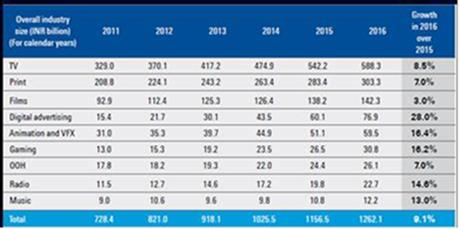Growth of the Indian film industry slowing down
While the dwindling screen counts and inconsistent content quality in Indian films are held responsible for the trend shift towards digital video consumption, a recent study finds out the disruption in the media industry.
The Federation of Indian Chambers of Commerce and Industry (FICCI) released a media and entertainment industry report depicting a 9.1 pc overall growth in 2016 despite demonetisation bringing a sudden shock at the end of the year. The report was launched in Mumbai yesterday and has holistically captured a comprehensive picture of India’s media industry growth, challenges, future projections and the key underlying themes.
The rural markets in the country are expected to contribute in all the key segments while the changing paradigm of economics in the country and a steady shift to digital mediums are expected to fuel a faster growth rate of 14 pc over the period of 2017-21. Girish Menon, the Director of Media and Entertainment, KPMG in India, said, “2016 was a mixed bag for the industry with digital media making its way to the centre stage rapidly from being just an additional medium. It is compelling existing players to rethink their business models. To accelerate growth, M&E organisations must rebuild their strategies to fit and thrive in the changing, digitally-oriented landscape. Nimbleness and flexibility will be at the core of sustainable businesses.”
Print media in 2016 witnessed a slowdown of 7 pc while television and films clocked a sluggish growth rate of 8.5 pc and 3 pc respectively. When compared to the likes of digital advertising (28 pc) and animation & visual effects (31 pc) – the traditional mediums in the Indian media industry have cut a rather sorry figure. “The long-term factors driving the future growth are expected to remain positive, with growing rural demand, increasing digital access and consumption, and the expected culmination of the digitisation process of television distribution over the next two to three years,“ Girish added.
Shrinking theatre audience
India is the largest producer of films in the world if not the most successful industry. However, the recent theatre revenue figures along with satellite deals across the country are appalling. Albeit theories from the FICCI Frames report suggest a turnaround in 2017, the segment remains sceptic. “Film as a segment was impacted by the decline in core revenue streams of domestic theatricals and satellite rights, augmented by poor box office performance of Bollywood and Tamil films. Expansion of overseas markets, an increase of depth in regional content and rise in acquisitions of digital content by over-the-top platforms are expected to be the future growth drivers that would help the segment bounce back at a forecasted CAGR of 7.7 pc,” the report states.
The inconsistency of quality content is another side of the poor performance of films as a medium in India. Bollywood in 2016 raked up a sum of INR 37 billion out of the 225 movies. However, the catch is only 50 films contributed 96 pc of the total box office share. Demonetisation was held responsible for the poor show of the industry in the last couple of months of 2016. However, Aamir Khan starrer, ‘Dangal’, proved how convincing stories and organic content will always evoke the passion of theatre watching irrespective of any situation.
In India, theatre ticket sales make about 70 pc of the total revenue, however, the decreasing number of screens hurt the scene even more. The closing of single screen theatres and also inadequate multiplexes in the country can be a major setback to the medium. The density of screens in India is as low as eight per one million viewers and that too only in the urban and semi-urban areas. Add to it, the increasing rate of piracy. The FICCI report points out that the film industry loses approximately INR 80 million every year due to piracy.
FICCI Frames also finds out how the overseas revenue is aiding the ailing film industry. A considerable 8 pc of the overall theatrical collection comes from the overseas markets. The southern films are the drivers in this regard. The United States (30 pc), the United Kingdom (20 pc) and the Middle East (25 pc) are three prime overseas markets for Indian films, the report noted.
Digital video consumption – a major drift
India is still considered as a sleeping giant as far as the huge potential of the rural India is concerned. The robust growth projections pointed by FICCI in the report has a huge implication of digital proliferation in rural India.
Commenting on the industry’s performance and way forward, Uday Shankar, the Chairman of the FICCI M&E Committee and Chairman & CEO of Star India said, “The industry has gulped down the bitter pill of demonetisation trusting its long-term benefits and yet is set to bounce back to a steady growth, thanks to strong fundamentals. Building solid infrastructure and continued government support will help the industry reach the tremendous potential it holds for employment and creating socio-economic value for the country. A commitment towards a quick transition to digitisation will ensure growth for all stakeholders.”
The report underlines some of the key aspects of the future media space in India and the likes of a surge in digital consumption has been the central theme led by burgeoning mobile Internet and smartphone penetration, roll out of 4G, government and private initiatives around public Wi-Fi, greater emphasis on broadband rollout by multiple system operators.
While observing the government policies and initiatives that are presumed to have wide-ranging impact, with some short-to-medium term damage, extended implications are positive for the industry. The report points out that demonetisation hampered growth in annual advertising spends by about 1.5-2.5 pc and the industry is expected to be a net beneficiary of GST primarily due to the availability of input credits across the board and inclusion of entertainment tax within the sphere of GST. “Consolidation is gaining momentum across the value chain with large players expanding their footprint resulting in an increase in overall deal values compared to the previous year,” the study predicts.


















